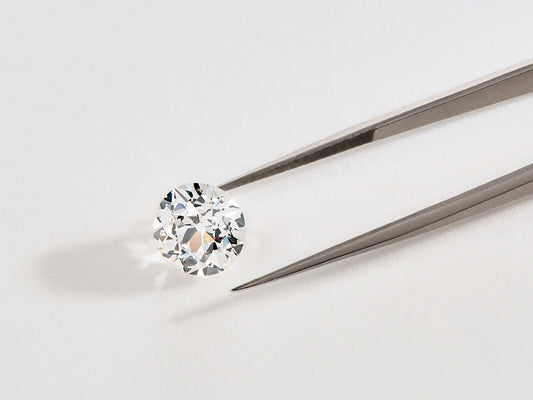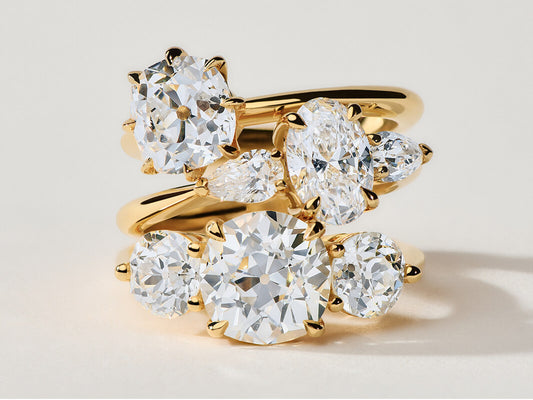DIAMOND CLARITY GUIDE
Clarity: Evaluating inclusions and blemishes to balance visual appeal and cost. We'll guide you through selecting the optimal clarity grade for your preferences and budget.
What Does Diamond Clarity Mean?
Diamond clarity refers to the absence of internal inclusions and surface blemishes. It's one of the four crucial factors (4 C's) that determine a diamond's quality and value.
The Gemological Institute of America (GIA) has developed a Clarity Scale that ranges from Flawless to Included. Professional gemologists assess diamonds under 10x magnification, meticulously examining for any imperfections. The resulting clarity grade is then included in the diamond's official certification report.
It's crucial to understand that many inclusions or blemishes are not visible to the naked eye. Diamonds without visible imperfections when viewed without magnification are termed 'eye clean'. This concept is particularly important when selecting a high-clarity diamond, as the difference between various clarity grades may not be noticeable without specialized equipment.
When choosing a diamond, consider that clarity grades beyond 'eye clean' may increase cost without providing a visibly discernible difference. Understanding the clarity scale and the concept of 'eye clean' diamonds can help you make an informed decision, potentially allowing you to optimize your budget without compromising on the diamond's apparent quality.
THE CUSHLA WHITING DIFFERENCE
Unless a specifically high clarity grade is requested, our Gemologist will skillfully select diamonds in the more economical clarity grades for our customers, while ensuring that they are 100% "eye clean" whether they be VS grade or SI grade. This means that there is no eye-visible difference between one of our carefully selected VS-SI diamonds and a flawless diamond. This takes great skill which has been honed over years of diamond buying experience as well as great patience in buying our diamond stock slowly over time .

Diamond Clarity Scale
In 1953, the GIA standardized the grades of cut, color, carat, and clarity (commonly referred to as the 4 C's). Today, their 6-category, 11-level Clarity Scale is used around the world to determine the level of imperfections within a diamond.
DIAMOND CLARITY SCALE EXPLAINED
- No inclusions or polish features visible under 10x magnification. Less than 1% of all diamonds are FL clarity, as it is nearly impossible to find a diamond that is completely inclusion-free.
- Flawless diamonds are clean of inclusions and blemishes under 10 x magnification.
- No inclusions are visible under 10x magnification. Some minor polish features such as extra facets be present under a microscope.
- Internally Flawless diamonds are clean of inclusions under 10 x magnification.
- Inclusions are characterized as minute and are so slight that they are difficult for a skilled grader to see under 10x magnification.
- VVS1 and VVS2 diamonds are eye clean.
- Inclusions are observed with effort under 10x magnification but can be characterized as minor.
- VS1 and VS2 diamonds are generally eye clean.
- Inclusions are noticeable under 10x magnification.
- Some SI1 and SI2 diamonds may have inclusions that are detectable to the unaided, untrained eye, while others do not.
- Inclusions are seen without magnification, which may affect transparency and brilliance.
- CUSHLA WHITING does not carry Included grade diamonds as their imperfections are generally visible to the unaided, untrained eye.
How is Diamond Clarity Graded?
Diamond clarity grading is a precise process conducted by professional gemologists. Using 10x magnification, they evaluate each diamond for the number, size, visibility, nature, and position of imperfections, as well as their overall impact on the stone's appearance. Based on these assessments, the diamond is assigned one of 11 specific clarity grades on the GIA scale. For diamonds of 1 carat or larger, Gemologists also create a unique "plot" for each diamond - a visual diagram mapping its imperfections, which serves as a fingerprint for identification. This detailed evaluation process helps to document the diamond's unique characteristics and determine its clarity grade. However, it's important to note that many of these imperfections are not visible to the naked eye, especially in higher clarity grades. When selecting a diamond, consider how the clarity grade balances with other factors like cut, color, and carat weight to find the best value for your preferences and budget.
Size
The size of an inclusion significantly influences a diamond's clarity grade, with larger inclusions generally having a greater impact. However, size is always considered relative to the diamond's overall dimensions. It's important to note that large inclusions, especially those near the surface or reaching it, can potentially affect the diamond's durability. When selecting a diamond, consider how the size of any inclusions might impact both its appearance and long-term resilience.
Number
While the visibility of inclusions is more crucial than their quantity, a higher number of clarity characteristics typically results in a lower clarity grade. However, this relationship isn't strictly linear. A few prominent inclusions might have a more significant impact than numerous tiny ones. Understanding this nuance can help you make a more informed decision when comparing diamonds of similar clarity grades.
Position
The location of an inclusion or blemish within a diamond plays a crucial role in its clarity grading. Imperfections can occur anywhere in or on a diamond, but those nearest to the table (the large, flat facet on top) tend to have the most significant impact on clarity. This is because they're more visible when viewed face-up, the typical way a set diamond is seen. Consider the position of inclusions when evaluating a diamond's overall appearance and value.
Nature
The nature of an imperfection refers to its type and depth within the diamond. Internal characteristics are called inclusions, while external ones are blemishes. Different types of inclusions can have varying effects on a diamond's appearance and durability. For instance, feathers (small cracks) near the surface might pose more risk than deeper, more stable inclusions. Understanding the nature of inclusions can help you assess a diamond's long-term value and resilience.
Relief
Relief describes how distinct an inclusion or blemish appears in contrast to the diamond itself. Low relief inclusions, which are transparent or white, are less noticeable than high relief (dark) inclusions. The greater the relief, the more it impacts the overall clarity grade. However, the visibility of an inclusion's relief can vary under different lighting conditions. When examining a diamond, consider how its inclusions appear under various lights to get a comprehensive understanding of their impact on the stone's appearance.

Inclusions and Blemishes
Understanding diamond inclusions and blemishes requires knowledge of diamond formation. Natural diamonds develop deep within the Earth when carbon is subjected to extreme heat and pressure. This intense process often results in trapped crystals, forming the internal characteristics we call inclusions. The most common types are pinpoints (tiny dots) and feathers (small internal breaks).
Lab-grown diamonds also have inclusions, but they're often described differently in grading reports. For instance, what the GIA might term a "pinpoint" or "feather" in a natural diamond report could be labeled a "growth remnant" in a lab diamond report.
External imperfections, known as blemishes, occur in both natural and lab-grown diamonds after their formation. These typically result from the cutting process, mounting, or everyday wear of the polished diamond.
Understanding these characteristics can help you make an informed decision when selecting a diamond, whether natural or lab-grown. Remember, most inclusions and blemishes are not visible to the naked eye, especially in higher clarity grades.
Inclusion
Inclusions are internal imperfections that occur during diamond formation.
CAVITY
An angular opening that occurs as a feather breaks further (usually during polishing).
CLOUD
A cluster of pinpoints that give a hazy appearance.
CRYSTAL
A mineral crystal within a diamond.
FEATHER
A small breakage or crack that appears white and feathery.
GRAINING
Lines, angles, and curves that can appear whitish, colored, or reflective.
NEEDLE
A thin, elongated crystal that looks like a rod at 10x.
KNOT
A white or transparent crystal that extends toward the diamond's surface.
PINPOINT
A small crystal that looks like a tiny dot at 10x magnification
Blemishes
Blemishes are external imperfections that occur after diamond formation.
ABRASION
A series of nicks that give the edges a white, fuzzy appearance.
CHIP
A shallow opening on a stone's surface that most often occurs at the girdle or culet.
NATURAL
A portion of the original surface of a rough diamond that's usually left on the girdle.
NICK
A small notch, usually along the girdle edge or culet.
PIT
A small opening that appears as a tiny white dot.
ROUGH GIRDLE
A granular girdle surface.
SCRATCH
A thin white line along the diamond's surface.

How Important Is Diamond Clarity?
Clarity plays a crucial role in determining a diamond's overall appearance, quality, and price.
APPEARANCE: Diamonds with numerous or significant inclusions may appear less brilliant and sparkle less than those with higher clarity grades. The positioning and nature of inclusions can affect how light interacts with the diamond, potentially impacting its overall radiance.
QUALITY: A diamond's durability can be compromised by certain inclusions. Large feathers or inclusions near the surface may increase the risk of chipping or fracturing, potentially affecting the diamond's longevity.
PRICE: Flawless and Internally Flawless diamonds command premium prices due to their extreme rarity. However, eye-clean or Slightly Included diamonds often offer excellent value, balancing visual appeal with more accessible pricing. Understanding these clarity-price relationships can help you make an informed decision that aligns with your preferences and budget.

Tips for Choosing a Clarity Grade
The most critical factor in diamond clarity is whether the stone is "eye-clean" - free from visible inclusions to the naked eye. While Flawless is the top technical grade, there's no visible difference between a Flawless diamond and an eye-clean diamond of a lower grade.
It's crucial to understand that significant variations can exist within the same GIA clarity grade, especially in lower grades. Generally, VS1 and above are typically eye-clean, VS2 is usually eye-clean but not always, while only about 30% of SI1 and 3% of SI2 diamonds are eye-clean.
Contrary to popular belief, higher clarity grades don't necessarily mean more sparkle. Well-chosen VS and SI diamonds can exhibit the same brilliance as Flawless or VVS diamonds if they have comparable cut quality.
For round diamonds, eye-clean SI1 stones often offer excellent value. However, for fancy cuts (ovals, pears, marquise, radiant), VS clarity is often preferred due to the limited availability of well-cut diamonds in these shapes. Step-cut diamonds (emerald, Asscher) typically require VS clarity or higher, as their faceting style makes inclusions more noticeable.
Understanding these nuances can help you make an informed decision, balancing visual appeal with value when selecting a diamond.

OVER 20 YEARS OF DIAMOND BUYING EXPERIENCE
In our experience, having been buying diamonds for 20 years the best diamond for you will be a unique combination of the 4 C's that fits your preferences and budget. If clarity is very important to you, you could choose a smaller, warmer-colored diamond. If carat is the most important to you, choose a larger diamond with a lower grade in clarity and cut.
It's always best to see a diamond in person before purchasing it. Especially if you have yet to see many or any diamonds before, seeing one in front of you is much more informative than seeing the video online. We recommend booking an appointment to view diamonds in our showroom so our experts can walk you through clarity and the other 4 C's in real-time.
The Importance of DIAMOND CLARITY
LIGHT PERFORMANCE: Clarity can affect how light interacts with a diamond. Higher clarity grades typically allow for better light transmission, potentially enhancing the diamond's brilliance and sparkle.
VISUAL APPEAL: Fewer inclusions and blemishes generally result in a cleaner, more visually appealing diamond. Significant flaws can potentially impact the stone's overall appearance.
VALUE
MARKET PRICE: As one of the "Four Cs", clarity significantly influences a diamond's value. Rarer, higher clarity diamonds often command premium prices, especially in larger carat weights where small clarity differences can substantially affect cost.
Personal Significance
SYMBOLIC MEANING: In engagement rings or heirloom pieces, some choose higher clarity diamonds to represent purity or perfection in a relationship.
OWNER SATISFACTION: Understanding a diamond's quality, including its clarity grade, can enhance the owner's appreciation and enjoyment of the stone.
Grading and Resale
CERTIFIED QUALITY: Clarity is a key factor in diamond grading by respected institutions like the GIA. A high clarity grade in certification can increase a diamond's desirability.
RESALE POTENTIAL: Higher clarity grades often correlate with better resale value, potentially offering more flexibility if the diamond is sold or traded in the future.
In conclusion, while clarity is an important factor in a diamond's overall quality and value, it's crucial to balance it with other characteristics. For many buyers, an eye-clean diamond offers an optimal combination of visual appeal and value, regardless of its technical clarity grade. Understanding clarity can help you make an informed decision that aligns with your preferences and budget.
DIAMOND CLARITY FAQs
Flawless is the highest clarity grade, indicating no inclusions or blemishes visible under 10x magnification. These diamonds are extremely rare and command premium prices.
A diamond is considered 'eye clean' when it has no inclusions or blemishes visible to the naked eye at a viewing distance of 10-20 cm. Many diamonds with lower clarity grades can still be eye clean.
Brilliant-cut diamonds like oval, cushion, radiant, marquise, and pear shapes tend to conceal clarity flaws better than step-cut diamonds due to their faceting pattern. This can allow for more flexibility in choosing clarity grades.
Clarity refers to the presence or absence of internal inclusions and surface blemishes in a diamond. Color, on the other hand, measures the absence of color, with completely colorless diamonds being the most valuable in the standard scale.
Clarity assesses the presence of inclusions and blemishes in a diamond. Cut evaluates the quality of a diamond's faceting and proportions, which directly affects its light performance - fire, sparkle, and brilliance.
Higher clarity grades generally correspond to higher prices, with the effect becoming more pronounced in larger carat weights. However, the price difference between eye-clean diamonds of different grades may not always justify the cost.
Yes, clarity is important for all diamonds in a piece of jewelry. Eye-clean side stones and accent diamonds contribute to the overall beauty and quality of the piece.
Yes, lab-grown diamonds can have inclusions, though they may differ from those in natural diamonds. Certification reports might use different terminology for lab-grown diamond inclusions, such as 'growth remnant' instead of 'inclusion'.